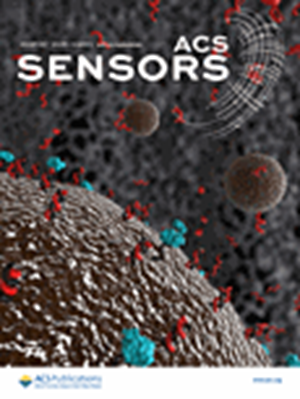集成蛋白酶传感器的纳米纤维素伤口敷料用于伤口病原体检测。
IF 8.2
1区 化学
Q1 CHEMISTRY, ANALYTICAL
引用次数: 0
摘要
伤口感染导致愈合延迟,发病率和败血症风险增加。早期发现伤口感染可以促进治疗并减少过度使用抗生素的需要。蛋白酶在愈合过程中通常是活跃的,但在感染过程中作为炎症反应的一部分过度表达。感染伤口的细菌也会产生蛋白酶,这使得蛋白酶成为感染监测的高度相关的生物标志物。在这里,我们展示了一种荧光开启传感器,用于实时监测先进纳米纤维素伤口敷料中的蛋白酶活性,以快速检测伤口病原体。通过精心优化的自组装工艺,将胶体金纳米颗粒(AuNPs)吸附在细菌纤维素(BC)纳米原纤维上。aunp既可以均匀地掺入BC敷料中,也可以使用BC- aunp墨水在木材衍生纤维素纳米纤维(CNF)敷料中进行3D打印。bc吸附的AuNPs随后用荧光团标记的蛋白酶底物功能化。伤口病原菌金黄色葡萄球菌和铜绿假单胞菌产生的蛋白酶切割底物,导致荧光显著增加,这与细菌的生长阶段有关。带有检测蛋白水解活性的集成传感器的伤口敷料可以敏感和快速地检测感染,从而优化治疗并降低并发症的风险。本文章由计算机程序翻译,如有差异,请以英文原文为准。
Nanocellulose Wound Dressings with Integrated Protease Sensors for Detection of Wound Pathogens.
Wound infections result in delayed healing, morbidity, and increased risks of sepsis. Early detection of wound infections can facilitate treatment and reduce the need for the excessive use of antibiotics. Proteases are normally active during the healing process but are overexpressed during infection as part of the inflammatory response. Proteases are also produced by the bacteria infecting the wounds, making proteases a highly relevant biomarker for infection monitoring. Here, we show a fluorescence turn-on sensor for real-time monitoring of protease activity in advanced nanocellulose wound dressings for rapid detection of wound pathogens. Colloidal gold nanoparticles (AuNPs) were adsorbed on bacterial cellulose (BC) nanofibrils by using a carefully optimized self-assembly process. The AuNPs could either be homogeneously incorporated in BC dressings or 3D printed in wood-derived cellulose nanofiber (CNF) dressings using a BC-AuNP ink. The BC-adsorbed AuNPs were subsequently functionalized with fluorophore-labeled protease substrates. Cleavage of the substrates by proteases produced by the wound pathogens Staphylococcus aureus and Pseudomonas aeruginosa resulted in a significant increase in fluorescence that correlated with the growth phase of the bacteria. Wound dressing with integrated sensors for the detection of proteolytic activity can enable the sensitive and rapid detection of infections, allowing for optimization of treatment and reducing the risks of complications.
求助全文
通过发布文献求助,成功后即可免费获取论文全文。
去求助
来源期刊

ACS Sensors
Chemical Engineering-Bioengineering
CiteScore
14.50
自引率
3.40%
发文量
372
期刊介绍:
ACS Sensors is a peer-reviewed research journal that focuses on the dissemination of new and original knowledge in the field of sensor science, particularly those that selectively sense chemical or biological species or processes. The journal covers a broad range of topics, including but not limited to biosensors, chemical sensors, gas sensors, intracellular sensors, single molecule sensors, cell chips, and microfluidic devices. It aims to publish articles that address conceptual advances in sensing technology applicable to various types of analytes or application papers that report on the use of existing sensing concepts in new ways or for new analytes.
 求助内容:
求助内容: 应助结果提醒方式:
应助结果提醒方式:


